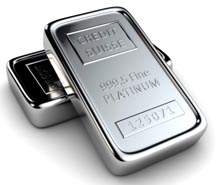( This article is written by Riya Singh, Research Analyst – Currency and Commodities, Emkay Global Financial Services Ltd.)

Mumbai: In a twist that would make even the most cunning foxes in folklore proud, India’s bullion dealers have discovered a loophole in the Comprehensive Economic Partnership Agreement (CEPA) that has turned the gold import market into a whimsical game of hide and seek. By donning the glittering disguise of platinum, these traders are evading high import duties with the finesse of a master illusionist.
Imagine this: since mid-June, the flow of what is ostensibly platinum into India has eclipsed the entire import volume for 2023. Dealers have cleverly registered alloys containing around 90% gold as platinum, a sleight of hand that has allowed them to skirt around the higher duties imposed on gold. In this four-week period, a staggering 13 metric tons of these “platinum” consignments, worth nearly $1 billion, have passed through customs. For context, total platinum imports in 2023 amounted to just 9.97 metric tons.
The secret behind this magical transformation lies in a government rule that classifies an alloy with just 2% platinum as platinum. It’s a loophole big enough to drive a gold-laden truck through, and the dealers have done just that. Since April 1, thanks to CEPA signed with the UAE, import duties on platinum have been a mere 5%, compared to the hefty 15% on gold. This 10% difference in duty means dealers can offer refined gold at discounts of up to 2%, leaving those who import gold legitimately paying the full duty scratching their heads and clutching their ledgers in dismay.

India, the world’s second-biggest consumer of gold, now finds itself in a curious predicament. These crafty imports are not just a matter of creative bookkeeping but have real economic consequences. New Delhi is losing significant tax revenue, and the influx of this misclassified metal is skewing local market prices. Gold discounts in India have ballooned to $34 an ounce over official domestic prices, the highest in nearly three and a half months, up from a modest $9 just a fortnight ago. This is a scenario wherein even after giving upfront discount, these importers would still be making profit
The roots of this caper stretch back to when platinum commanded higher prices than gold. The current rule was logical then, but with platinum now trading at a discount and benefiting from lower import duties under CEPA, it’s a recipe for exploitation. A revision of the definition is necessary.
Adding a dash of humour to this already absurd scenario, traders in Dubai have taken the concept of “value addition” to new heights—or lows, depending on your perspective. By mixing tiny amounts of platinum and copper into gold bars, they create an alloy that, on paper, qualifies for the lower import duty. These bars then make their way to India, where they are sold at a discount, distorting the market and leaving everyone from legitimate importers to government officials in a tizzy.
These antics may prompt a regulatory overhaul, but for now, they’re making the most of a loophole that turns gold into platinum with a mere wave of a legislative wand.



